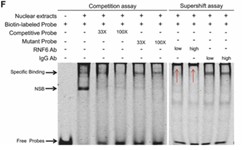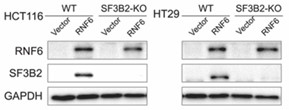SF3B2
-
Official Full Name
splicing factor 3b, subunit 2, 145kDa -
Overview
This gene encodes subunit 2 of the splicing factor 3b protein complex. Splicing factor 3b, together with splicing factor 3a and a 12S RNA unit, forms the U2 small nuclear ribonucleoproteins complex (U2 snRNP). The splicing factor 3b/3a complex binds pre-mRNA upstream of the introns branch site in a sequence-independent manner and may anchor the U2 snRNP to the pre-mRNA. Splicing factor 3b is also a component of the minor U12-type spliceosome. Subunit 2 associates with pre-mRNA upstream of the branch site at the anchoring site. Subunit 2 also interacts directly with subunit 4 of the splicing factor 3b complex. Subunit 2 is a highly hydrophilic protein with a proline-rich N-terminus and a glutamate-rich stretch in the C-terminus. -
Synonyms
SF3B2;splicing factor 3b, subunit 2, 145kDa;splicing factor 3b, subunit 2, 145kD;splicing factor 3B subunit 2;Cus1;SAP145;SF3b1;SF3b145;SAP 145;spliceosome associated protein 145;spliceosome-associated protein 145;pre-mRNA splicing factor SF3b
Recombinant Proteins
- Zebrafish
- Human
- Mouse
- Mammalian Cell
- HEK293
- HEK293T
- Mammalian cells
- His
- Non
- His&Fc&Avi
- Myc&DDK
- Flag
| Cat.# | Product name | Source (Host) | Species | Tag | Protein Length | Price |
|---|---|---|---|---|---|---|
| SF3B2-6004Z | Recombinant Zebrafish SF3B2 | Mammalian Cell | Zebrafish | His |
|
|
| SF3B2-1917HCL | Recombinant Human SF3B2 293 Cell Lysate | HEK293 | Human | Non |
|
|
| SF3B2-1989H | Recombinant Human SF3B2 Protein, His (Fc)-Avi-tagged | HEK293 | Human | His&Fc&Avi |
|
|
| SF3B2-1989H-B | Recombinant Human SF3B2 Protein Pre-coupled Magnetic Beads | HEK293 | Human |
|
||
| SF3B2-5388H | Recombinant Human SF3B2 Protein, Myc/DDK-tagged, C13 and N15-labeled | HEK293T | Human | Myc&DDK |
|
|
| Sf3b2-5810M | Recombinant Mouse Sf3b2 Protein, Myc/DDK-tagged | HEK293T | Mouse | Myc&DDK |
|
|
| SF3B2-739HFL | Recombinant Full Length Human SF3B2 Protein, C-Flag-tagged | Mammalian cells | Human | Flag | Full L. |
|
Background
What is SF3B2 protein?
SF3B2 gene (splicing factor 3b subunit 2) is a protein coding gene which situated on the long arm of chromosome 11 at locus 11q13. This gene encodes subunit 2 of the splicing factor 3b protein complex. Splicing factor 3b, together with splicing factor 3a and a 12S RNA unit, forms the U2 small nuclear ribonucleoproteins complex (U2 snRNP). The splicing factor 3b/3a complex binds pre-mRNA upstream of the intron's branch site in a sequence-independent manner and may anchor the U2 snRNP to the pre-mRNA. Splicing factor 3b is also a component of the minor U12-type spliceosome. Subunit 2 associates with pre-mRNA upstream of the branch site at the anchoring site. Subunit 2 also interacts directly with subunit 4 of the splicing factor 3b complex. The SF3B2 protein is consisted of 895 amino acids and SF3B2 molecular weight is approximately 100.2 kDa.
What is the function of SF3B2 protein?
SF3B2 is involved in the assembly of the spliceosome, a large ribonucleoprotein complex responsible for catalyzing the splicing reaction. In addition to its role in mRNA splicing, it plays a role in the regulation of RNA stability and RNA polymerase II activity. SF3B2 has been reported to have a dual function on chromatin and RNA, indicating its involvement in gene expression regulation at multiple levels. Recent research has suggested that SF3B2 may have a role in mRNA export, highlighting its importance in coordinating mRNA processing and export.
SF3B2 Related Signaling Pathway
SF3B2 is a core component of the U2 snRNP, which is essential for the splicing of pre-mRNA. It plays a role in the assembly of the spliceosome and is involved in catalyzing the splicing reaction. SF3B2 is involved in the regulation of RNA stability and RNA polymerase II activity, indicating its role in controlling gene expression at the RNA level. SF3B2 has been implicated in cell cycle regulation, DNA damage repair, and apoptosis, suggesting its involvement in maintaining genomic stability and cellular homeostasis. SF3B2 has a dual function on chromatin and RNA, suggesting its involvement in both the epigenetic regulation of gene expression and the processing of RNA.
SF3B2 Related Diseases
SF3B2 genetic disorders are primarily associated with its role in the splicing process and have been implicated in conditions such as craniofacial microsomia. Craniofacial microsomia is the second most common congenital facial anomaly and is characterized by underdevelopment of facial bones, including the mandible, and can involve other abnormalities such as microtia (underdeveloped ears), and epibulbar dermoids. SF3B2 mutations are also found in myelodysplastic syndromes (MDS) and other hematological malignancies, where they can affect the function of the spliceosome and lead to abnormal splicing events, contributing to disease pathogenesis.
Bioapplications of SF3B2
SF3B2, a component of the splicing factor 3B complex, has emerged as a protein with significant bioapplication potential, particularly in the context of cancer research and therapeutic development. High-resolution structural studies of the SF3B2 complex bound to small molecule drugs have provided insights into the mechanisms of action of these drugs and have informed the design of more effective splicing modulators. The dual function of SF3B2 in transcription regulation and RNA stability also highlights its potential as a biomarker for diseases such as head and neck squamous cell carcinoma, where its expression levels can indicate tumor progression and response to treatment.
Case Study
Case Study 1: Hui Xu, 2021
RNF6 is a RING finger protein with oncogenic potential. In this study, researchers established colon-specific RNF6 transgenic (tg) mice, and demonstrated that RNF6 overexpression accelerated colorectal carcinogenesis compared to wild-type littermates in a chemically induced colorectal cancer (CRC) model. To understand whether transcriptional activity of RNF6 underlies its oncogenic effect, they performed integrated chromatin immunoprecipitation (ChIP)-sequencing and RNA-sequencing analysis to identify splicing factor 3b subunit 2 (SF3B2) as a potential downstream target of RNF6. RNF6 binds to the SF3B2 promoter and the overexpression of RNF6 activates SF3B2 expression in CRC cells, primary CRC organoids, and RNF6 tg mice. SF3B2 knockout abrogated the tumor promoting effect of RNF6 overexpression, whereas the reexpression of SF3B2 recused cell growth and migration/invasion in RNF6 knockout cells. Targeting of RNF6-SF3B2 axis with SF3B2 inhibitor with pladienolide B suppressed the growth of CRC cells with RNF6 overexpression in vitro and in vivo.

Fig1. EMSA performed with biotin-labeled SF3B2 probes and SW480 nuclear extracts.

Fig2. RNF6 and SF3B2 protein expression were determined by Western blot.
Case Study 2: Ye Eun Jeong, 2023
Neurodegeneration induced by inflammatory stress in multiple sclerosis (MS) leads to long-term neurological disabilities that are not amenable to current immunomodulatory therapies. Here, researchers report that neuronal downregulation of Splicing factor 3b subunit 2 (SF3B2), a component of U2 small nuclear ribonucleoprotein (snRNP), preserves retinal ganglion cell (RGC) survival and axonal integrity in experimental autoimmune encephalomyelitis (EAE)-induced mice. By employing an in vitro system recapitulating the inflammatory environment of MS lesion, they show that when SF3B2 levels are downregulated, cell viability and axon integrity are preserved in cortical neurons against inflammatory toxicity. Notably, knockdown of SF3B2 suppresses the expression of injury-response and necroptosis genes and prevents activation of Sterile Alpha and TIR Motif Containing 1 (Sarm1).

Fig3. Representative images of differentiated N2A cells treated with SF3B2-GFP plasmid.

Fig4. mRNA expression levels of Sf3b2.
Quality Guarantee
High Purity
.jpg)
Fig1. SDS-PAGE (SF3B2-5388H)
Involved Pathway
SF3B2 involved in several pathways and played different roles in them. We selected most pathways SF3B2 participated on our site, such as Gene Expression,Processing of Capped Intron-Containing Pre-mRNA,Spliceosome, which may be useful for your reference. Also, other proteins which involved in the same pathway with SF3B2 were listed below. Creative BioMart supplied nearly all the proteins listed, you can search them on our site.
| Pathway Name | Pathway Related Protein |
|---|---|
| mRNA Splicing | CCAR1,DNAJC8,HNRPL,CD2BP2,PTBP1B,YBX1,TXNL4A,PDCD7,RNPC3,SF3A3 |
| mRNA processing | HNRNPAB,RBM4B,SF3A1,SFSWAP,ZFP346,RBM5,RBM39A,SFRS3A,WBP4,PTBP2 |
| Processing of Capped Intron-Containing Pre-mRNA | PCBP2,NUDT21,HNRNPR,CSTF2,CSTF1,SUGP1,ZMAT5,CD2BP2,U2AF2,SF3B4 |
| mRNA Splicing - Minor Pathway | ZCRB1,SF3B4,ZMAT5,PDCD7,PRPF8,RNPC3,SNRNP35,YBX1,SNRNP48,SNRNP25 |
| mRNA Splicing - Major Pathway | SF3B4,HNRNPH1L,PRPF8,HNRNPA2B1,HNRNPUL1,HNRNPA0L,HNRNPL2,SF3A3,HNRNPL,SF3A1 |
| Spliceosome | WBP11,BUD31,RBM8A,AQR,PQBP1,HNRNPA1,NHP2L1B,SFRS3B,THOC2,ALYREF |
| Gene Expression | ZKSCAN1,NSUN2,ZNF839,NELFE,ZNF649,EIF4B,SNAPC5,FARS2,ZNF561,WDR4 |
Protein Function
SF3B2 has several biochemical functions, for example, poly(A) RNA binding,protein binding. Some of the functions are cooperated with other proteins, some of the functions could acted by SF3B2 itself. We selected most functions SF3B2 had, and list some proteins which have the same functions with SF3B2. You can find most of the proteins on our site.
| Function | Related Protein |
|---|---|
| protein binding | ANXA4,IRAK2,RAD23B,TOMM34,SEC23IP,SDC4,BBS13,ARL4C,NFIX,SLC9A1 |
| poly(A) RNA binding | SECISBP2,CCDC124,WDR46,ALDH18A1,GTF2E2,RPS17,C14orf166,HIST1H4E,FAM120A,S100A4 |
Interacting Protein
SF3B2 has direct interactions with proteins and molecules. Those interactions were detected by several methods such as yeast two hybrid, co-IP, pull-down and so on. We selected proteins and molecules interacted with SF3B2 here. Most of them are supplied by our site. Hope this information will be useful for your research of SF3B2.
SF3B4;RNF113A;PRPF3;DHX16;KDM1A;SLU7;U2AF1;PRPF8;FRA10AC1
Resources
Related Services
Related Products
References
- Xu, WJ; Huang, HX; et al. Meta-analysis of gene expression profiles indicates genes in spliceosome pathway are up-regulated in hepatocellular carcinoma (HCC). MEDICAL ONCOLOGY 32:-(2015).
- Zhu, J; Chen, WR; et al. Ethoxyquin Prevents Chemotherapy-Induced Neurotoxicity via Hsp90 Modulation. ANNALS OF NEUROLOGY 74:893-904(2013).


